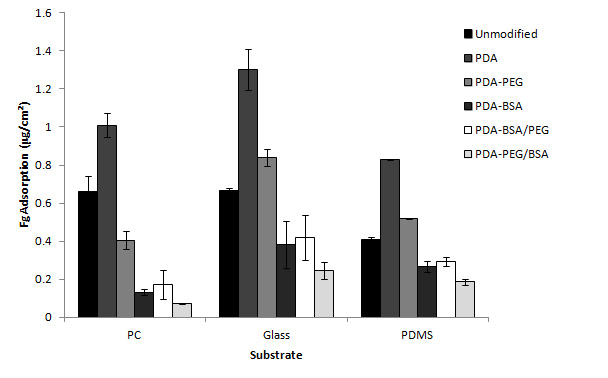Introduction: Preventing unwanted protein adsorption is important to improve implant biocompatibility, reduce biofouling, and control cell adhesion. A typical approach involves grafting polymers to alter surface chemistry. However, many surface modification protocols require harsh chemical conditions and solvents which may not be suitable for some materials. Thus, antifouling protocols need to consider the chemical stability of the substrate and, consequently, their applicability may be limited. This is of importance for biomedical devices which are composed of multiple classes of materials. Therefore, antifouling methods suitable for whole device modification are highly desirable [1],[2].
An aqueous-based polyethylene glycol (PEG) antifouling coating was previously developed using polydopamine (PDA) as a spacer [1]. PDA has been demonstrated to polymerize strongly onto virtually all material classes and readily forms covalent bonds with free amino groups.[3] However PEG grafting from solution may be sterically limited, leading to areas of exposed PDA available for protein binding.
We sought to improve this method by backfilling the PDA-PEG coating with a non cell-adhesive protein, bovine serum albumin (BSA). A previous study on PDA-BSA coated substrates reportedly reduced cell adhesion compared to PDA [4]. We hypothesized that the combination of PEG and BSA may reduce fouling to a greater degree than PEG alone.
Materials and Methods: Polydimethyl siloxane (PDMS), hydrophilic porous polycarbonate membranes (PC; 0.01 μm pore diameter), and borosilicate glass cover slips were incubated for 3 h with stirring in 2 mg/mL dopamine solution prepared in PBS, pH 8.5. The PDA coated surfaces were then incubated for 24 h in either (a): 10 mg/mL BSA (PBS, pH 7.4) at room temperature or (b): 5 mg/mL NH2-PEG-NH2 (MW 5000), (PBS, pH 8.5) at 37ºC or (c): (a) followed by (b) or (d): (b) followed by (a).
Fibrinogen (Fg) was radiolabeled with I-125 using the ICl method and passed through an ion exchange resin column to remove free iodide. The surfaces were incubated in 1 mg/mL Fg solution in PBS (5% labelled) for 2 h, and rinsed with buffer. Adsorption was quantified from radioactivity measurements.
Results and Discussion: Fg was used as a model protein to evaluate resistance to non-specific protein adsorption of the modified PDMS, glass, and PC. Adsorption data are shown in Figure 1. Consistent with previous reports [4], the PDA coated surfaces showed enhanced protein adsorption due to their ability to bind covalently to amino groups in Fg. Compared to the unmodified materials PEG modification was effective in reducing Fg adsorption only on PC. Interestingly, the PDA-PEG modified surfaces showed significantly higher Fg adsorption than the PDA-BSA, possibly due to the larger BSA molecules giving greater surface coverage. For all three substrates there was no significant difference in adsorption between PDA-BSA and PDA-BSA/PEG, possibly due to blockage of PEG attachment by the BSA. The lowest adsorption was seen on the PDA-PEG surfaces that were “backfilled” with BSA. These PDA-PEG/BSA surfaces showed reductions in Fg adsorption of 89%, 63%, and 55% for PC, glass, and PDMS, respectively.

Figure 1. Fg adsorption on different substrates. SEM ± mean for n=6 replicates and two trials. Protein concentration = 1 mg/mL.
Conclusions: Attachment of passivating moieties to a variety of material types using polydopamine as a bonding agent has been demonstrated. Backfilling PDA-PEG layers with albumin was shown to improve their antifouling properties. The modification was demonstrated on various types of materials, suggesting its utility as a universal antifouling coating. This strategy should be applicable to biomedical devices required to be non-fouling including implants and sensors.
Mitacs Globalink; Government of Ontario
References:
[1] H. Lee, et al., Science, 2007, 318, 426-430.
[2] M. Krishnamoorthy, et al., Chem Reviews, 2014, 114, 10976-11026.
[3] D. R. Dreyer, et al., Chemical Science, 2013, 4, 3796-3802.
[4] L. Zhu, et al., Colloids and Surfaces B: Biointerfaces, 2011, 86, 111-118.